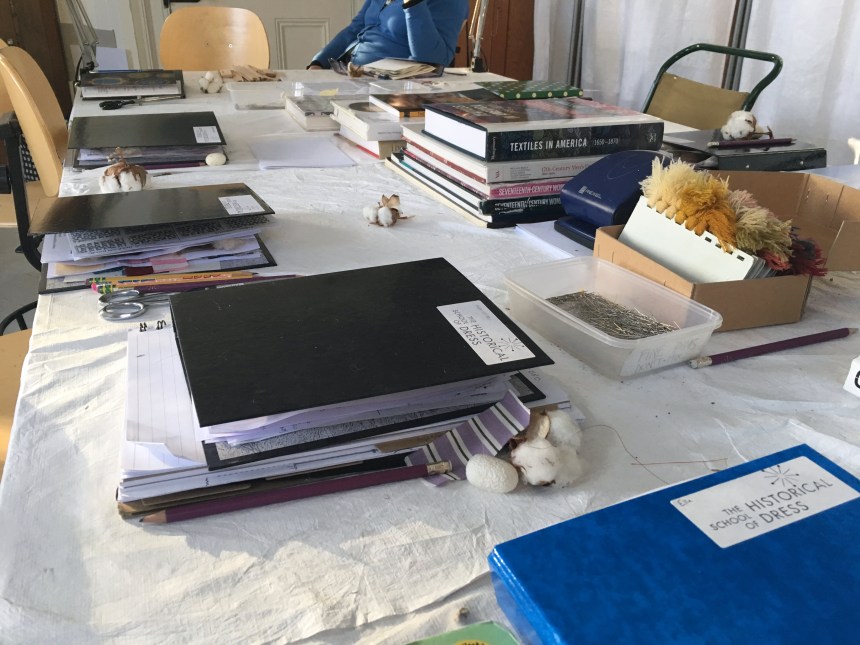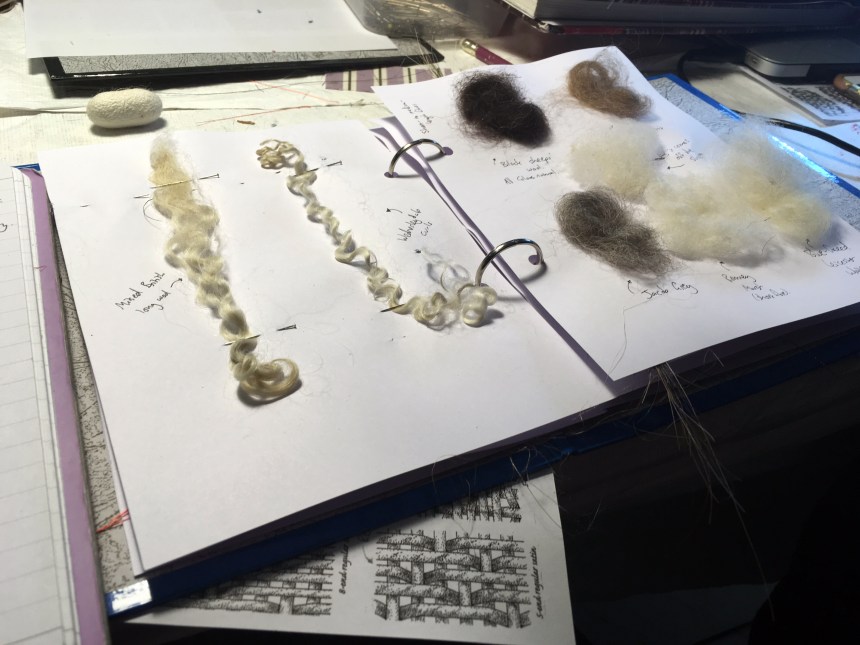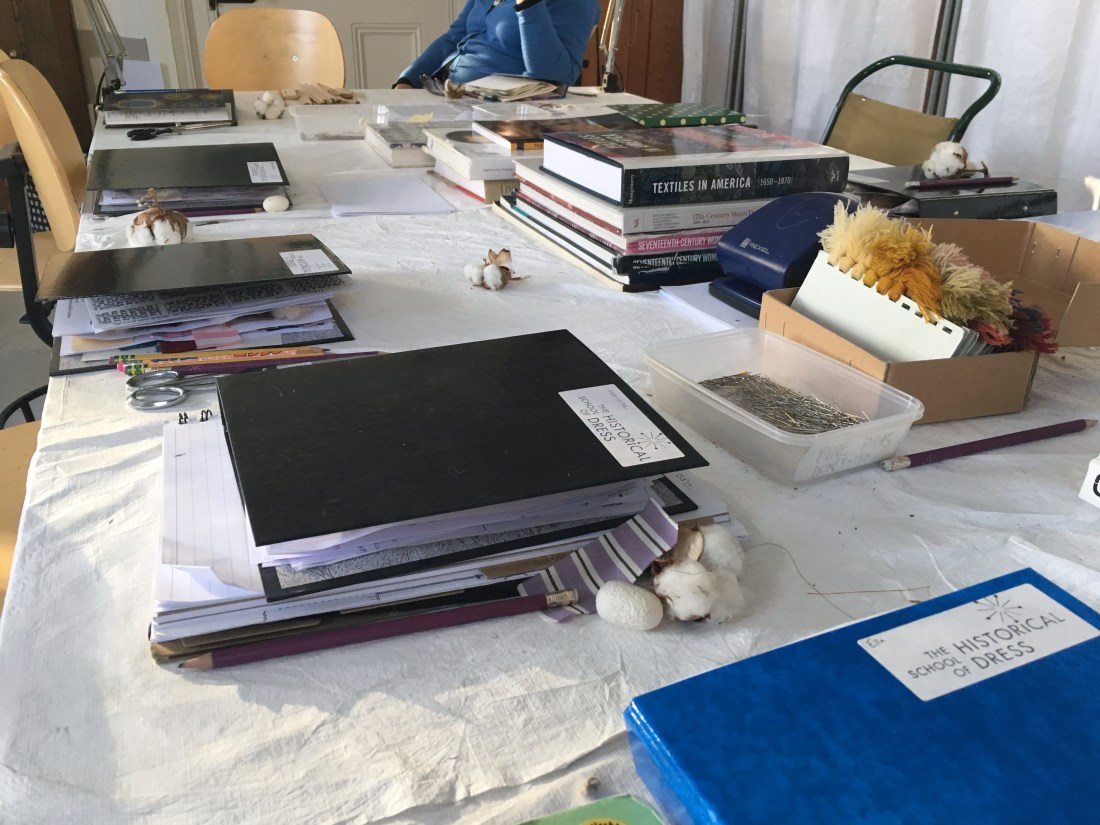I recently attended my second short course at The School of Historical Dress.
Having spent a weekend back in October learning all about the history of tailoring (read all about the experience here), my goal for this second course was to find out more about the various fabrics that have been used for tailoring and dressmaking through the centuries.
The Nature of Fabrics c.1400 – 1800 was exactly the course I hoped it would be. Led by Jenny Tiramani (former Director of Theatre Design at Shakespeare’s Globe Theatre), the weekend was an in-depth insight into how various forms of fabric have historically been made and used. Nine students had travelled to London from around the world to attend the two-day course; the excitement was palpable as we settled into the School’s teaching room, surrounded by stacks of fabric samples, books, and archive boxes.

The first part of the course involved looking at the different natural fibres that are used to create linen, hemp, wool, and silk. We were each given samples of the fibres at various stages of their development into usable threads. Some samples showed the fibres in their raw state, while others had been bleached. We pinned these into folders alongside small lengths of thread and squares of fabric made from the same fibres.


We then moved on to thinking about the different weaving patterns that have long been used to transform individual threads into lengths of fabric. With the help of some handy diagrams, it was soon possible to differentiate between fabrics that had been woven with a plain, twill, or satin weave. A second haul of fabric samples were pinned into our folders, each carefully labelled with details of the fibre, weave, and resulting fabric type.

As we worked through the various fabric types, Jenny talked about how different textiles were used and valued in the past. For example, sumptuary proclamations issued by Elizabeth I give a fascinating insight into how textiles were linked to social status in the 16th century: purple silk couldn’t be worn by anyone under the degree of an Earl, and crimson velvet was restricted to those at/above the status of a Knight, a member of the Privy Council, or a Gentleman of the Privy Chamber. We also heard how Jenny and her colleagues have made use of reproduction fabrics when recreating historical dress for the stage, for exhibitions, or to feature in one of the many books produced by members of the School (more on that below!).

The second day of the course provided an excellent opportunity for us to put our new knowledge into practice. Jenny showed us several items from the School’s impressive collection of historical fabrics and garments. We saw a section of scarlet brocade dating back to the 16th-century, a beautiful piece of 16th/17th-century wool with appliquéd details, green (silk cut velvet) cloth of gold and silver tissued, and a mid-17th-century religious effigy robe in pink cloth of silver tinsel. Excitingly, we were able to look at these items in far more detail than I expected: Jenny used a digital microscope to give us a close-up view of each fabric, meaning we were able to understand exactly how each had been woven and embroidered.

We were also able to use the microscope to compare the weaves and patterns of historical and reproduction fabrics side-by-side. I was particularly excited to see the original piece of stamped velvet that had inspired the fabric pattern for the dress worn by Mark Rylance’s Olivia in Twelfth Night (2012). When designing the production, Jenny had the ‘strapwork’ pattern woven into a roll of velvet by Guiseppe Gaggioli, the last remaining weaver on the Via dei Velluti, Zoagli – an Italian street formerly filled with highly skilled weavers. The techniques used to produce the cut and uncut black silk velvet (pictured below) had been passed down from generation to generation, making the resulting fabric the closest possible equivalent to what would’ve been worn by the aristocracy (and members of playing companies) in Shakespeare’s day.

After lunch, Vanessa Hopkins (Trustee of the School and expert in 18th-century dress fabrics) showed us several items from her large collection of 18th-century fabrics. As per the fashions of the period, most had been woven into fabulous floral patterns in shades of pink, blue, and cream. We were also able to see several surviving garments from the period, including a taupe bodice with scalloped sleeves and a gorgeous 1730s cream silk gown with silver brocaded motifs.


The course drew to a close on a definite highlight: Jenny lit a candelabra and showed us how some of the earlier fabrics (particularly those woven and embroidered with metal threads) glistened in the candlelight. It was wonderful to see how early modern players and audience members would have sparkled in the candle-lit, indoor playhouses of the 16th/17th centuries, and the experience was a fitting end for a weekend filled with discoveries about the exquisite nature of historical fabrics.

Photographs included with kind permission from Jenny Tiramani, Vanessa Hopkins, and The School of Historical Dress.
My research and my attendance at these courses is generously funded by the Midlands3Cities AHRC Doctoral Training Partnership.
